Travel@Taipei
- Yangmingshan National Park
Yangmingshan National Park is located at the north edge of the Taipei Basin. It covers a total area of 11,455 hectares with elevations of between 200 and 1120 meters above sea level. The park is famous for its unique volcanic geology and topographical sights, with signs of volcanic activity like fumaroles and hot springs everywhere. Due to its accessibility for the people of northern Taiwan, on weekends and holidays the park attracts countless hikers and other visitors who come to enjoy the scenery.
Xiaoyoukeng
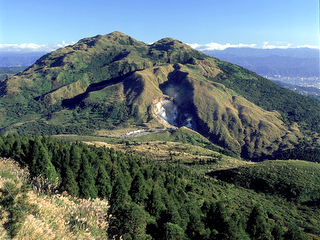 Xiaoyoukeng is a post-volcanic geological landscape area and is located on Mt. Qixing's northwestern foot. It is approximately 805 meters above sea level and is famed for the fumaroles, sulfur crystals, hot springs and spectacular 'landslide terrain' formed by post-volcanic activity. In addition to Xiaoyoukeng itself, the viewing platform here also offers views of the volcanic cones of Mt. Zhuzi, Mt. Datun, Mt. Qixing and Mt. Xiaoguanyin, as well as views of the Jinshan coastline.
Xiaoyoukeng is a post-volcanic geological landscape area and is located on Mt. Qixing's northwestern foot. It is approximately 805 meters above sea level and is famed for the fumaroles, sulfur crystals, hot springs and spectacular 'landslide terrain' formed by post-volcanic activity. In addition to Xiaoyoukeng itself, the viewing platform here also offers views of the volcanic cones of Mt. Zhuzi, Mt. Datun, Mt. Qixing and Mt. Xiaoguanyin, as well as views of the Jinshan coastline.
Flower Clock
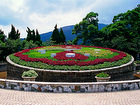 Located approximately 1.8 km below the Yangmingshuwu is the Houshan Park part of Yangming Park. It is under the jurisdiction of the Taipei City Government Yangming Park Headquarters. The most famous sight in the park is the flower clock, made with seasonal flowers and plays music at regular intervals. The flower clock is a popular tourist site and photo spot.
Located approximately 1.8 km below the Yangmingshuwu is the Houshan Park part of Yangming Park. It is under the jurisdiction of the Taipei City Government Yangming Park Headquarters. The most famous sight in the park is the flower clock, made with seasonal flowers and plays music at regular intervals. The flower clock is a popular tourist site and photo spot. - Taipei 101
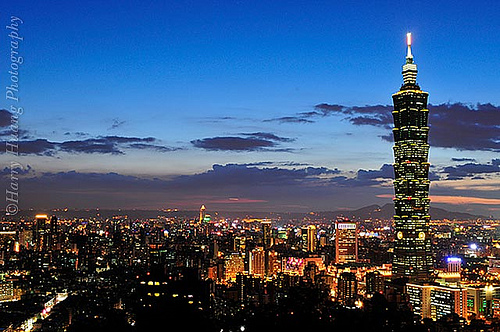 Taipei 101 had its grand opening in 2004. Being the landmark of Taipei City, it was designed in eight sections, according to Chinese lucky number eight. This building is a skyscraper comprises of one hundred and one floors with the fastest elevators in the world that can travel ninety floors in only thirty-seven seconds (sixty four point four kilometers per hour approximate).
Taipei 101 had its grand opening in 2004. Being the landmark of Taipei City, it was designed in eight sections, according to Chinese lucky number eight. This building is a skyscraper comprises of one hundred and one floors with the fastest elevators in the world that can travel ninety floors in only thirty-seven seconds (sixty four point four kilometers per hour approximate).
With one hundred and one floors, Taipei 101 features different usages. Parking lots from B2 to B4, shopping centers from B1 to the fourth floor, while banks and financial centers on the fifth floor. From the sixth to the eightieth floor are occupied by business offices. A VIP Club is available on the eighty-fifth floor. For refined cuisines and views, visitors may enjoy fine services and cuisines at the restaurants located from the eighty-sixth to the eighty-eighth floor. For great views of entire Taipei City, an indoor viewing area is accessible on the eighty-ninth floor, and an outdoor viewing area is on the ninety-first floor.
Taipei 101 is nearby large numbers of department stores and attractions, including New York New York, Eslite Bookstore, Shin Kong Mitsukoshi Department Stores, Taipei World Trade Center (TWTC) and many more. Visitors are able to shop boutique brands, such as Louis Vuitton, Coach, Gucci, Tiffany & Co and Chanel. Xinyi area is also a prosperous area for exotic restaurants, cinema, night clubs, and other entertainments. - National Palace Museum
The National Palace Museum houses the world's largest collection of priceless Chinese art treasures, one which spans China's nearly 5,000-year history. Most of the museum's 620,000 art objects were part of the Chinese imperial collection, which began over 1,000 years ago in the early Song dynasty.
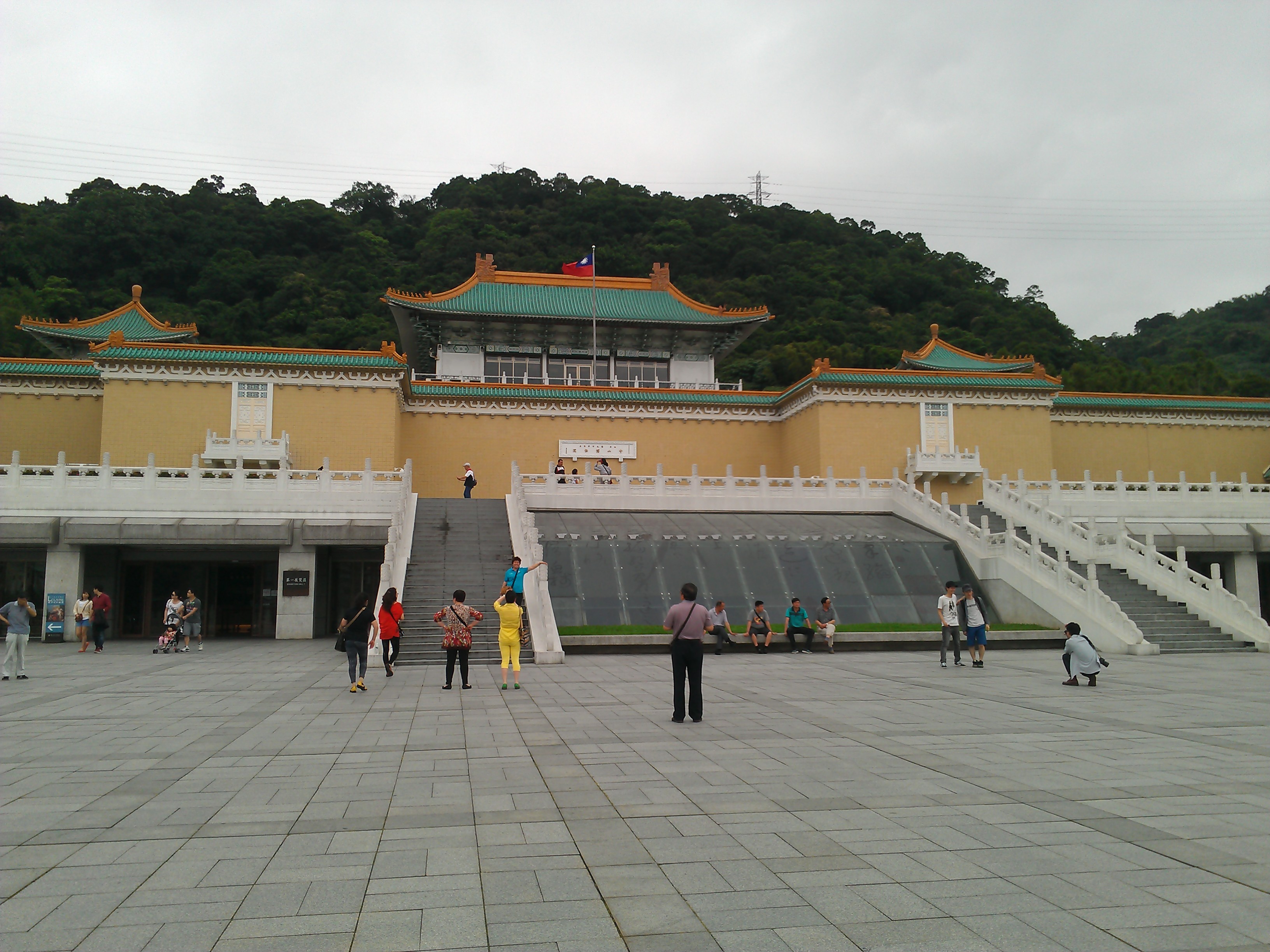 The collection of cultural artifacts held inside the National Palace Museum consists an enormous treasure trove of objects from the Song, Yuan, Ming and Qing Dynasties. Development of the Museum is closely connected to the social changes of modern China. Thirteen years after the founding of the Republic of China, the last Qing Emperor Puyi was exiled from the Forbidden City. The cultural artifacts left within the palaces were collectively itemized, and a National Palace Museum was born.
The collection of cultural artifacts held inside the National Palace Museum consists an enormous treasure trove of objects from the Song, Yuan, Ming and Qing Dynasties. Development of the Museum is closely connected to the social changes of modern China. Thirteen years after the founding of the Republic of China, the last Qing Emperor Puyi was exiled from the Forbidden City. The cultural artifacts left within the palaces were collectively itemized, and a National Palace Museum was born.
Aiming to preserve the imperial collections and palatial treasures from the various Chinese dynasties, the National Palace Museum was officially open on October 10, 1925, allowing members of the public and future generations to enter the Palace to admire this cultural inheritance. - Yehliu Natural Landscape
Mushroom Rock
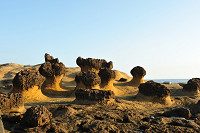 The mushroom rocks grouped on the wave-cut platform are formed with globe-shape rocks on the top while supporting by the thin stone pillars on the bottom. Queen’s Head is the most famous mushroom rock in Yehliu.
The mushroom rocks grouped on the wave-cut platform are formed with globe-shape rocks on the top while supporting by the thin stone pillars on the bottom. Queen’s Head is the most famous mushroom rock in Yehliu.
Two broken concretions within rock layers are formed vertical to the sea level; as a result, the erosion caused by seawater may progress along the concretions, leading to the formation of stone pillar lining up in row.
The formation of mushroom rock is caused by differential erosion as the top rock layer containing calcium and being more durable for erosion than the lower rock layer.
The mushroom rock as formed is under continuous plate extrusion and thus is raised above sea level. Once it’s exposed to the planet’s atmosphere, it will suffer from weathering as well as rain erosion and turn into the shape as we see it now.
The mushroom rocks can be divided into three types according to the difference appearances as manifested on the head and neck of the rock: “Thin-neck rock”,” thick-neck rock” and “neckless rock”. As many of the thin-neck mushroom rocks undertake heavier load on the top and they may be toppled down easily if striking by earthquake or violent winds and waves.
The mushroom rocks may turn into various kinds of shapes in a progressive manner as they are chronically eroded by wind, sun and rain. They may involve into neckless rock, thick rock, thin rock and even the broken-end rock eventually. The top of the thin rock may fall apart if the neck of the rock contains incomplete sands and thud accelerating the formation of broken-end rock.
Queen’s Head
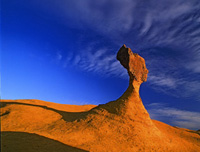 Queen’s Head, one of the most famous scenes in Yehliu, is a kind of mushroom rock. It is formed due to the differential erosion caused by seawater during curst movement. When comparing the height of which with the crust’s rising rate, it is assessed that the age of the rock is about 4,000 years old. The so called “Queen’s Head” is in fact a mushroom rock; it gets the title because the shape as formed after the top of rock being fallen apart in 1962~1963 appears like the side face of Queen Elizabeth.
Queen’s Head, one of the most famous scenes in Yehliu, is a kind of mushroom rock. It is formed due to the differential erosion caused by seawater during curst movement. When comparing the height of which with the crust’s rising rate, it is assessed that the age of the rock is about 4,000 years old. The so called “Queen’s Head” is in fact a mushroom rock; it gets the title because the shape as formed after the top of rock being fallen apart in 1962~1963 appears like the side face of Queen Elizabeth.
Queen’s Head is regarded as the landmark of Yehliu, yet its fame doesn’t bring any good to itself since it not only undertakes natural devastation but also being spoiled by mankind. The narrowest part around it neck is about 138 cm now.
Mazu Cave
A small-size sea cave called Mazu Cave stands between the first and the second area. Two hundred years ago, one fisherman discovered a piece of Mazu statue inside a sea cave when he was collecting lavers in this area. Local people couldn’t afford to build a temple to settle the statue thus they put it inside a cave. Yet, the place was not a safe location to settle the statue since it was frequently tortured by monsoon and typhoon. One night, Mazu made her presence before the fisherman saying her desire of being settled in Jinshang; it was when the Ci Hu Temple was build up in 1809 B.C to consecrate Mazu. Now, a religious parade of Mazu will be performed regularly on the 16th day of the fourth month in lunar calendar every year.
fisherman discovered a piece of Mazu statue inside a sea cave when he was collecting lavers in this area. Local people couldn’t afford to build a temple to settle the statue thus they put it inside a cave. Yet, the place was not a safe location to settle the statue since it was frequently tortured by monsoon and typhoon. One night, Mazu made her presence before the fisherman saying her desire of being settled in Jinshang; it was when the Ci Hu Temple was build up in 1809 B.C to consecrate Mazu. Now, a religious parade of Mazu will be performed regularly on the 16th day of the fourth month in lunar calendar every year. - Taipei Confucius Temple
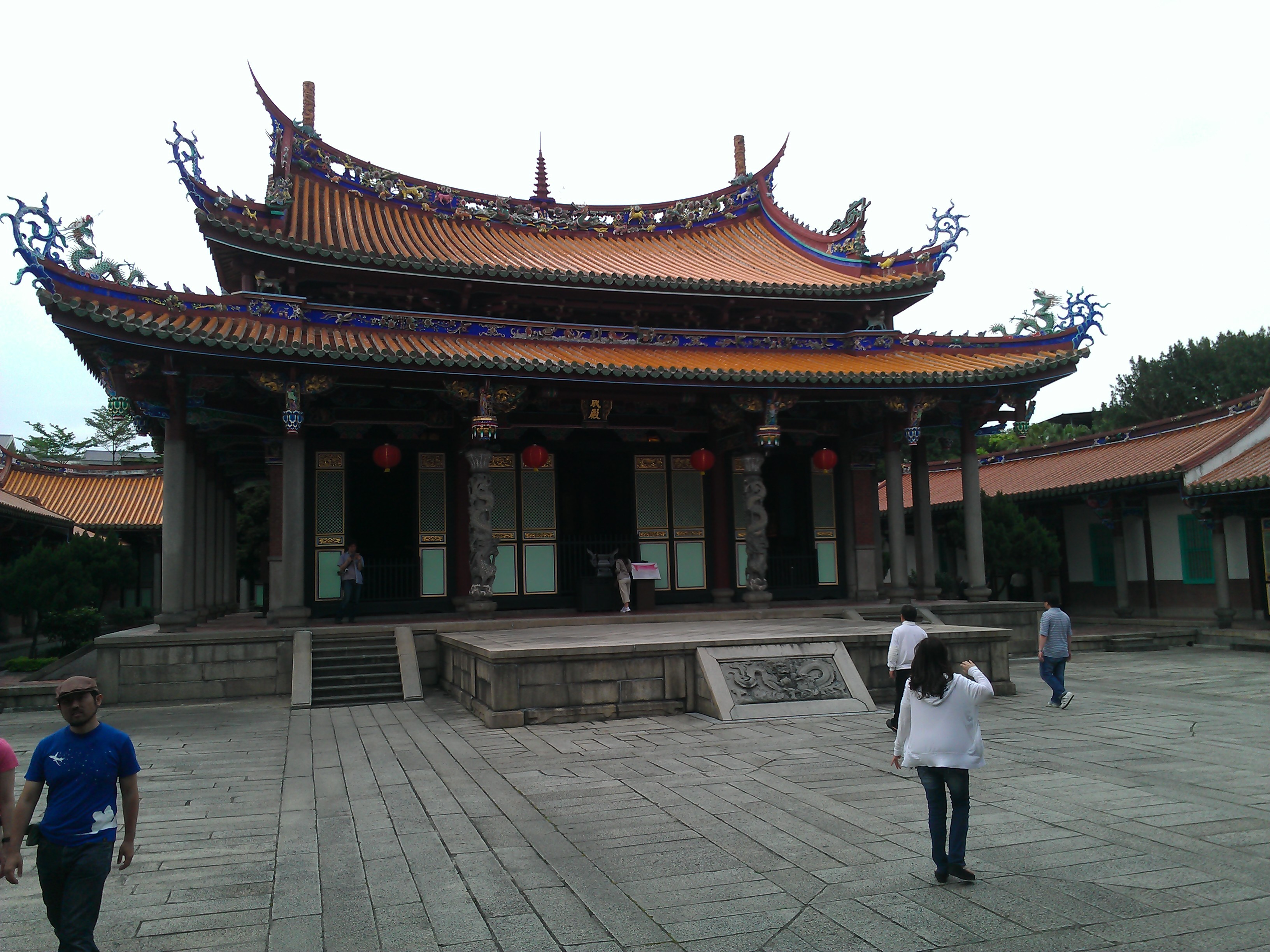 This temple honors one of the greatest philosophers and teachers of all time, Confucius, as well as other philosophers. Confucius valued simplicity, and simplicity is the dominant characteristic of his temple. Here you see none of the densely rich decor of many other temples; even the usual stone lions are missing from the entrance. The columns, doors, and windows here are also different, in that they bear no inscriptions. This indicates, it is said, that nobody dares flaunt his literary prowess before the Master. Nor are there any images in this temple. In ancient times, Confucius temples contained images of the Sage, but different craftsman carved them in different likenesses. This lack of uniformity upset Emperor Tai Tsu (reigned A.D. 1368) of the Ming dynasty, who decreed that
This temple honors one of the greatest philosophers and teachers of all time, Confucius, as well as other philosophers. Confucius valued simplicity, and simplicity is the dominant characteristic of his temple. Here you see none of the densely rich decor of many other temples; even the usual stone lions are missing from the entrance. The columns, doors, and windows here are also different, in that they bear no inscriptions. This indicates, it is said, that nobody dares flaunt his literary prowess before the Master. Nor are there any images in this temple. In ancient times, Confucius temples contained images of the Sage, but different craftsman carved them in different likenesses. This lack of uniformity upset Emperor Tai Tsu (reigned A.D. 1368) of the Ming dynasty, who decreed that 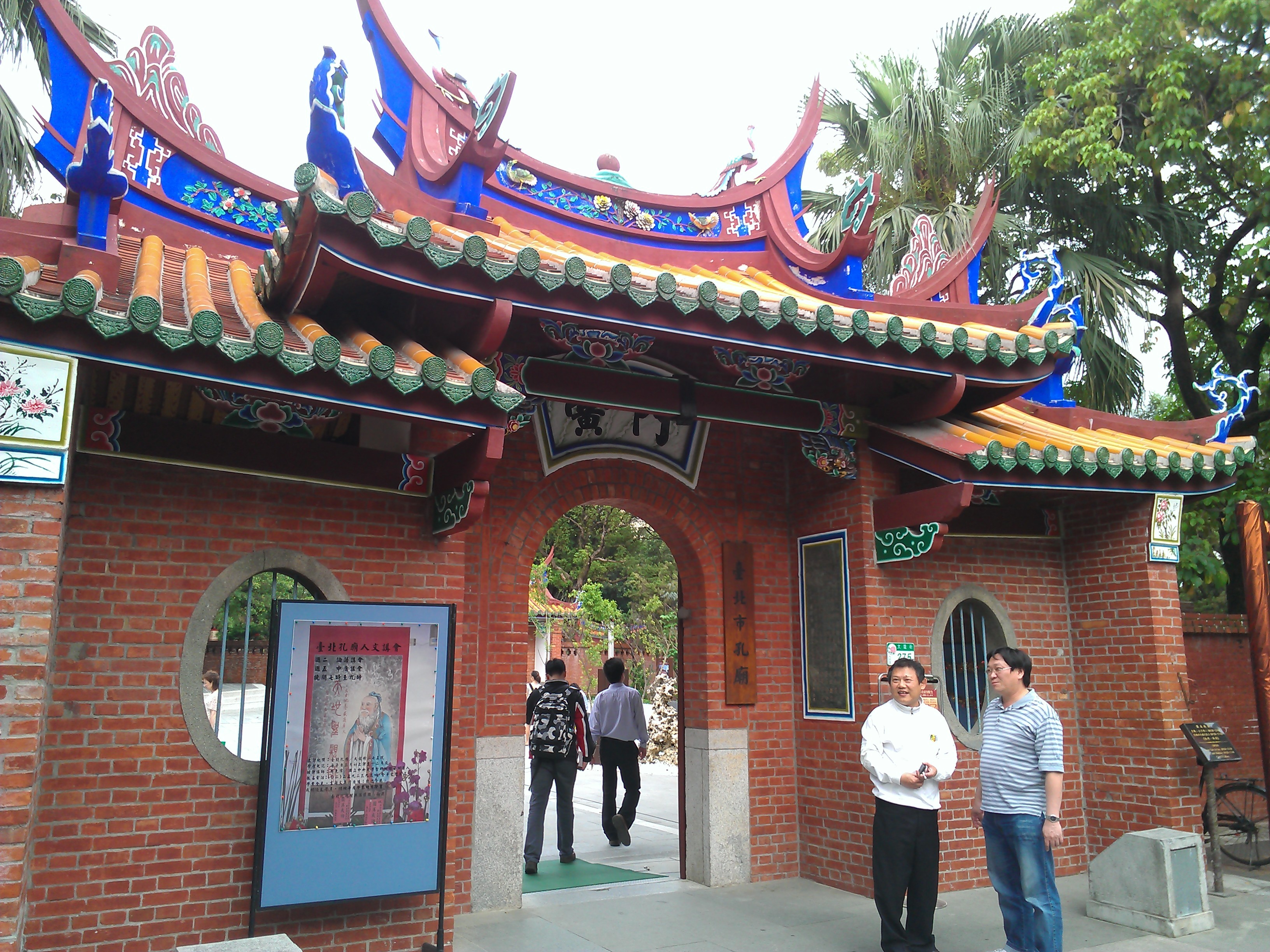 all new Confucius temples would henceforth contain only memorial tablets and no images. Later on, during the reign of emperor Shi cong (1522-1586), it was decreed that all existing images of Confucius be replaced with memorial tablets. This rule is still followed today. Standing outside of Dacheng Hall, the main hall of this temple, you can see a pair of upright cylinders in the center of the roof. These are called book-hiding barrels, and there is a story behind them. In ancient times, the first Emperor (reigned 246-214 B.C.) of the Qin dynasty wanted to keep his people illiterate so that they would not challenge his rule; he had books burned and scholars killed. To save their beloved books, students hid them in rooftop containers built to look like chimneys.
all new Confucius temples would henceforth contain only memorial tablets and no images. Later on, during the reign of emperor Shi cong (1522-1586), it was decreed that all existing images of Confucius be replaced with memorial tablets. This rule is still followed today. Standing outside of Dacheng Hall, the main hall of this temple, you can see a pair of upright cylinders in the center of the roof. These are called book-hiding barrels, and there is a story behind them. In ancient times, the first Emperor (reigned 246-214 B.C.) of the Qin dynasty wanted to keep his people illiterate so that they would not challenge his rule; he had books burned and scholars killed. To save their beloved books, students hid them in rooftop containers built to look like chimneys.


